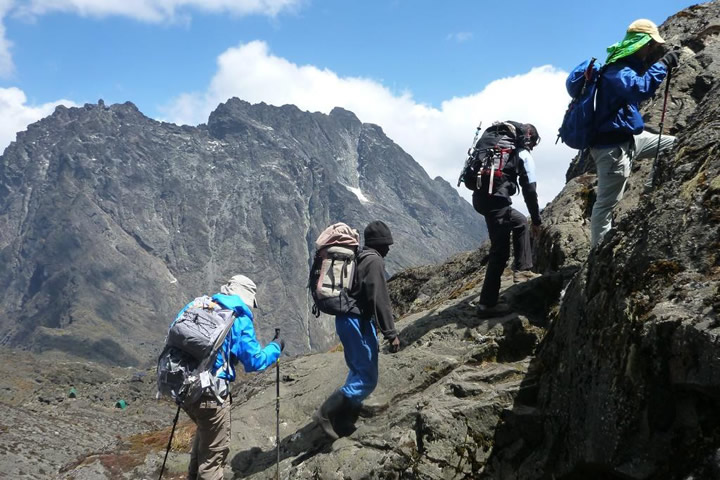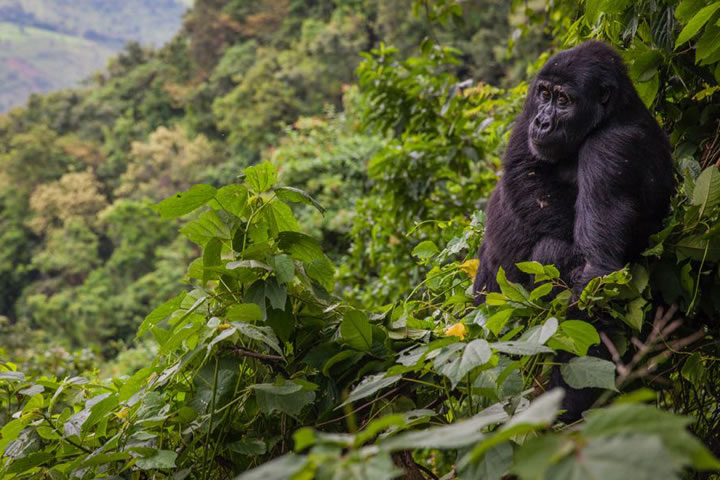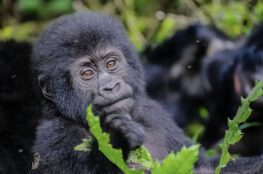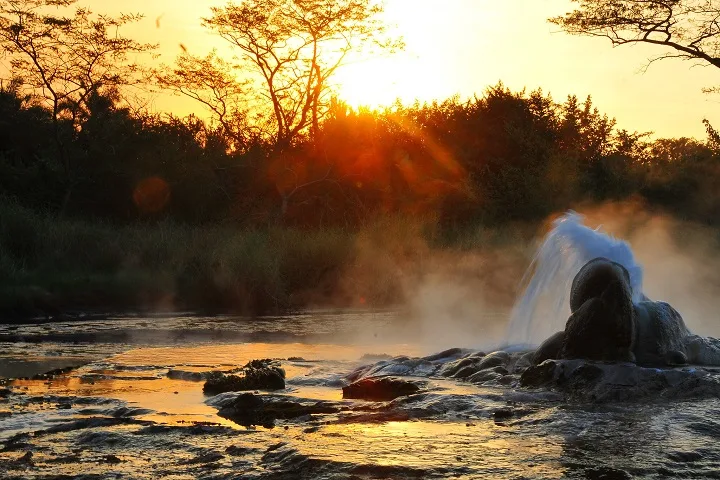Embark on an epic 15-Day Mountaineering and Wildlife Safari in Uganda, where adventure meets wildlife in one unforgettable journey. Scale the majestic Rwenzori Mountains, trek through lush forests, and witness mountain gorillas and chimpanzees in their natural habitats. Experience thrilling game drives in Uganda’s top national parks, encounter the Big Five, and explore stunning landscapes and vibrant local cultures. This safari is perfect for those seeking a blend of mountaineering challenges and extraordinary wildlife encounters

The 15-day Mountaineering and Wildlife Safari in Uganda, also known as the “Pearl of Africa,” combines thrilling mountaineering, awe-inspiring wildlife encounters. This itinerary takes you deep into the heart of Rwenzori Mountains National Park, home to the legendary Rwenzori Mountains, where you’ll challenge yourself with high-altitude treks through glacial peaks and lush montane forests. After your mountain conquest, unwind and explore the rich biodiversity of Queen Elizabeth National Park, known for its tree-climbing lions and boat safaris along the Kazinga Channel. Finally, venture into the dense jungles of Bwindi Impenetrable National Park for a once-in-a-lifetime experience—tracking endangered mountain gorillas in their natural habitat. This trip blends adventure, nature, and cultural encounters, offering the best of Uganda in just over two weeks. This itinerary is designed for adventurous travellers seeking a deep and diverse immersion in Uganda’s natural wonders.
Summary
Day 1: Arrival
Day 2: Transfer to Kasese
Day 3: Hiking to Nyabitaba Hut 2652m
Day 4: Hiking to Nyamileju Hut, 3320m
Day 5: Hiking to John Matte hut, 3415m
Day 6: Hiking to Bujuku Hut, 3962m
Day 7: Hiking to Lake Kitandara hut, 4027m
Day 8: Descending to Nyabitaba Hut
Day 9: Descend from the Mountain
Day 10: Transfer to Queen Elizabeth National Park
Day 11: Whole day in Queen Elizabeth National Park
Day 12: Transfer to Bwindi National Park
Day 13: Gorilla Trekking, Bwindi National Park
Day 14: Bwindi National Park to Entebbe
Day 15: Departure
Day 1: Arrival
Please arrive at Entebbe Airport, where your guide will warmly greet you and transfer you to your hotel. Depending on your arrival time, you will have optional activities: a walk through the town, a nature walk in the Botanical gardens, or a boat trip to Ngamba Island chimpanzee sanctuary.
Overnight at Airport Guest House/Green Valley Guest House BB
Day 2: Transfer to Kasese
Your guide will collect you from the hotel and set off for Kasese, arriving in the afternoon. Your guide will go to the park offices in the evening to finalise your following mountaineering logistics, returning in the evening.
Dinner and overnight at Margherita Hotel/ Ruboni Community Camp/Equator Snow FB
Day 3: Hiking to Nyabitaba Hut, 2652m
This morning, you will begin your hike by leaving the park headquarters (5400ft, 1,646 m), walking past typical “wattle and mud” Bakonjo homes, and gradually moving upward through elephant grass and garden plots. It takes approximately forty minutes to reach the Rwenzori Mountains National Park boundary (which can be a pleasant half or one-day trip for someone not going further). The trail then follows the Mahoma River after about two and a half hours. After crossing the River, you will have a very steep climb through open bracken fern slopes and Podocarpus forest up to Nyabitaba Hut (8,700 ft/ 2,652), reached about an hour and a half past the Mahoma River crossing. During this part of the trip, you may be able to see Chimps, and at the same time, behind the Hut, you can see Black and White Colobus and Blue monkeys or catch glimpses of a brilliantly –colored Rwenzori Turaco (a bird of the tree tops).
Overnight at Nyabitaba hut
Day 4: Hiking to Nyamileju Hut, 3320m
From Nyabitaba Hut, that trail leads westward for a half km then drops north (right) steeply to Kurt Shafer Bridge, crossing below the confluence of Bujuku and Mubuku Rivers. By turning down the bridge, you begin the circuit counterclockwise.
After crossing the Shafer Bridge, the muddy, slippery trail climbs steadily up through a bamboo forest. After one and a half hours, you encounter an area of slippery boulder hopping, which many hikers consider the most difficult and dangerous footing on the circuit. Nyamileju means “a place of beards”, referring to the lichen and Spanish moss draping trees nearby. On a rare day, Mts. Stanley and Speke can be seen from the top of the rock near the Hut.
Overnight at Nyamileju Hut
Day 5: Hiking to John Matte hut, 3415m
After breakfast, you will continue to John Matte Hut (11,200 ft, 3,414 m), which is through a tiring bog full of these extraordinary plants, and the slow pace can be a delightful chance to examine and photograph this unique environment. Well situated, John Matte is newly constructed, large and comfortable, though muddy around the site. Hikers who feel they have reached their limits by this point should consider John Matte a reasonable stopping point. You can just enjoy the unique vegetation in the bog and the great views, and the following day, begin your return to Nyabitaba.
Day 6: Hiking to Bujuku Hut, 3962m
You leave John Matte Hut to cross the Bujuku River and enter the lower of the two Bigo Bogs, where your first real experience jumping from tussock to tussock in a grassy bog begins. The trail is very muddy and follows the left (southern) edge of Lower Bigo Bog until eventually it reaches the round metal “uniport” of Bigo Hut and its rock shelter.
A steep section past the hut leads to Upper Bigo Bog. In the last half of this blog, a boardwalk has been constructed. Though some may think it an ugly intrusion, it makes walking easier and keeps hikers from further damaging the bog. An hour and a half beyond the upper bog, and after climbing through drier ground and crisscrossing the River, you reach Bukulu Lake. The southern end of the lake is a majestic setting, with Mt. Bakerto to the south, and views west to Mt Stanley and north to Mt. Speke. Beyond the north end of the lake is a rock shelter called Cooking Pot, and a short distance further is Bukulu Hut (13,000ft/3,962m), favorably located for parties climbing Mt. Speke.
Day 7: Hiking Lake Kitandara hut, 4027m
To continue the circuit, you leave directly west from Bujuku hut on a newer trail, which rises and falls twice before Nally climbing steeply through magical moss-draped Groundsel Gully towards (14,345ft/4,372m) Scott Elliot pass. At the head of the gully is a short, strong ladder at a particularly steep section, after which a right-hand branch would lead to Elena Hut (14, 700ft/4,430m). This is a steep, rocky trail, which, when wet or icy, is treacherously slippery. Continuing straight, and a few steps below the pass, there is a sheltered spot for a break. From here, there is a second trail to the right that leads to Elena, which is the Base Camp for climbing. Margherita peak on the Mt. Stanley complex, which requires an additional day or two, can only be attempted with an ice axe, mountain boots, crampons, ropes and prior arrangements with RMS guides. Overnight at Kitandara Lake Hut
Day 8: Descending to Nyabitaba Hut
After breakfast, you will probably begin very early if you decide to make it to the Park Headquarters and complete your trek (8 hours). The other alternative will be to spend a night at the Nyabitaba Hut.
Day 9: Descend from the Mountain
Start sloping back and get back to the park office. If time allows, you will visit a simple restaurant developed by a local ladies’ group for a beer and a luxurious candlelight meal.
Overnight at either Ruboni Community Camp/Equator Snow FB
Day 10: Transfer to Queen Elizabeth National Park
After breakfast, you will head for Queen Elizabeth National Park, having a game drive while entering the park. In the evening, relax around the pool after lunch and later go for an early evening game drive. It’s little wonder that Queen Elizabeth boasts one of the highest biodiversity ratings of any game park or reserve in the world, from the open Savannah to Rain Forest, dense Papyrus Swamps and brooding Crater lakes to the vastness of Lake Edward.
Almost 100 mammal species that include Lions, Hippos, Buffaloes, Leopards, Spotted Hyenas, Elephants and the elusive Giant Forest Hog, plus a remarkable over 600 bird species that include the Black Chested Eagle, the Swallow-Tailed Bee Eaters, to mention but a few. The Primates include Chimps, Black and White Colobus Monkeys, Blue, Black Faced Red Colobus, and Red-Tailed Monkeys and Olive Baboons.
Reptiles are amazing, huge Rock-Python, Puff adders, Spitting Cobras, Gabon Rippers, Green Mambas, and Turtles, etc. All these are regularly sighted around the tourist village on the Mweya Peninsula, and all this makes a superb safari territory. Birding is also wonderful. Queen Elizabeth Park has the highest recorded number of over 600 species of birds, including the Shoebill Stork, Black Bee-Eater, Chappirs Fly Catcher, Bustards, and craters full of Lesser Flamingos, etc.
Overnight at Kingfisher Lodge, Kichwamba/Irungu Lodge FB
Day 11: Whole day in Queen Elizabeth National Park
Early morning drive to the crater lakes, where you may get a chance of seeing thousands of colourful Lesser Flamingos, as they feed in these soda lakes. Then go for the afternoon boat trip along the Kazinga Channel. Hippopotamus huff and spray mere feet away from the boat, Buffalo linger in the shallows, and a tremendous variety of birds grace the grasses on the shores. Great White and Pink-Backed Pelicans, Great and Long-Tailed Cormorants, Open-Billed Stork, African Jacana, Malachite and Pied Kingfishers are commonly seen. February and March offer spectacular sightings of some of the bird migrants.
Overnight at Kingfisher Lodge, Kichwamba/Irungu Lodge FB
Day 12: Transfer to Bwindi National Park
This morning, we will have a game drive to the Kisenyi area to look for Lion prides and other wildlife like the Uganda Kob that mate around this area, then head for Bwindi Impenetrable National Park, Best known for its Mountain Gorillas, the Montane Forest also attracts spectacular birds. There are 23 of the 24 Albertine Rift endemics, including the African Green Broadbill, Bar-Tailed Trogon and other beautiful forest species. You may decide to relax in the afternoon or take a nature walk through the surrounding area with spectacular views of the hillside. You will need to have a good night’s rest to get ready for the following day’s gorilla tracking.
Overnight at Rushaga Gorilla Camp/Broadbill Forest Camp FB
Day 13 – Gorilla Trekking Bwindi National Park
Trekking – Bwindi Impenetrable National Park. There will be a briefing at the park offices before starting the trek. (You are advised to wear hiking shoes, long-sleeved shirts & a light rain jacket.) Packed lunch is prepared by the camp, but you may bring more drinking water. The trek may take between 3 and 8 hours, but it’s well worth the effort. There are always ranger guides with you who interpret the flora and fauna and the lifestyle of the Gorillas.
Overnight at Rushaga Gorilla Camp/Broadbill Forest Camp FB
Day 14 – Bwindi National Park-Entebbe
After breakfast, you will proceed to Entebbe, passing through the “Switzerland” of Africa (Kabale) with beautiful scenery and terraced farming, arriving in the evening.
Overnight at Airport Guest House/Green Valley Guest House BB
Day 15 –Departure
You will be transferred to the airport later for your departure flight.


